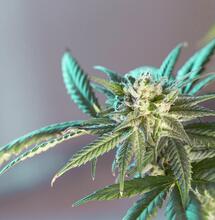Cannabis and Cartels
_28.jpg)
There is a common misconception that the Cannabis trade is less profitable than that of cocaine; while this may be true in some cases, Cannabis is becoming so economically important that involvement in the trade is a game that few can afford not to play.
There is a common misconception that the Cannabis trade is less profitable than that of cocaine; while this may be true in some cases, Cannabis is becoming so economically important that involvement in the trade is a game that few can afford not to play. We all associate cocaine with the Latin American narcotics trade. We have an idea of how many lives are lost or ruined, how many societies damaged by the industry.
But while we are similarly aware of the fact that a huge percentage of the Cannabis consumed in the US comes from Latin America, few realize the true significance of this sector of the trade. There is a common misconception that the Cannabis trade is less profitable than that of cocaine; while this may be true in some cases, Cannabis is becoming so economically important that involvement in the trade is a game that few can afford not to play.
Marijuana is King
According to many in the industry these days. Issues within the cocaine trade - namely an apparent decline in production and availability, and a slight worldwide drop in overall consumption - have led the guys at the top to redouble their focus on Cannabis, which suffers very little fluctuation in value through time, and is currently experiencing an increase in demand.
Coca is a far harder plant to cultivate and process for sale than Cannabis: it requires very specific habitats to grow, and dangerous and costly procedures to turn it into cocaine. As the wholesale cost of a shipment of cocaine is usually many times that of marijuana, it is more difficult for traffickers to attain the needed funds, and more damaging if shipments are lost.
Cartels
The Mexican cartels (particularly the Sinaloa, Gulf and Juárez), responsible for the vast majority of narcotics entering the US, also have to buy cocaine from Colombia or another producer country; marijuana production is usually domestic, so it's simpler to obtain. Lastly, the authorities in both the US and the various countries where cocaine is produced have made it their main priority, leaving marijuana growers slightly less exposed.
It is believed that marijuana now accounts for up to 60% of the cartels' profits - up to $9 billion per year. Of both products, the overwhelming majority is brought through the southwestern US/Mexico border, and the trade is controlled by the same handful of powerful cartels. Some marijuana is also smuggled in from Canada; comparatively tiny amounts make it through from Southeast Asia; the occasional boat or plane may bring pot-carrying mules direct from other Latin American or Caribbean countries.
Cocaine is also occasionally brought via mule direct from Bolivia, Colombia or Peru. However, a brief look at the trafficking figures at the southern border is all we need: between 2005 and 2009, seizures of cocaine dropped significantly, although with some fluctuation, from 22,653 kilos to 17,085. Marijuana seizures, on the other hand, went from 1.03 million kilograms in 2005 to 1.49 million in 2009, with a slight drop in 2008 the only anomaly (www.justice.gov).
Growth
Due to the massive growth in the domestic market in recent years, Latin American marijuana producers have seen their traditional product becoming less desirable compared with the high-potency, expertly-grown indoor varieties that are now available. The drive to introduce new, higher-strength genetics to the gene pool has closed the gap slightly, and the average potency of imported pot has apparently increased - at least according to the University of Mississippi's Potency Research Project (www.olemiss.edu), which holds that the overall increase in Cannabis potency is 'mainly due to the increase in the potency of non-domestic versus domestic samples'.
Generally, the better the product, the more it will fetch on the open market; in the case of Latin American pot, the increasing quality has offset the downward price trend, generally keeping prices stable over time. In 1991, the cost of a pound of commercial Mexican or Colombian weed lay somewhere between $450 and $1600 (depending on quality and distance from the border); today, things haven't changed much.
However, if you take dollar inflation into account, its value in real terms has dropped somewhat, making it even more affordable for today's (usually) higher salaries. Domestically-produced indoor Cannabis has mostly increased in price - roughly proportional to the increase in quality - over the same period, especially recently in California due to the Federal crackdown on dispensaries, so the incentive to opt for the cheaper import has not disappeared.
The Growers
At the other end of the supply chain, the Latin American marijuana farmer can expect to receive $15 to $20 for a couple of pounds, which again hasn't varied much over the years - except occasionally in response to sudden changes in availability. Any decreases in price or purchasing power the growers may have felt over the recent years of high dollar inflation can often be offset by simply increasing production, and indeed cultivation in Mexico is at its highest point in two decades, having surged by around 59% between 2003 and 2010 (from 13,500 tons to 21,500).
Moving the areas of production to more remote mountain areas has kept the growers difficult to find; eradication teams have largely been relocated to the front lines of the bloody war being fought in the cities on the Mexican side of the border, as well as to the cocaine- and methamphetamine labs. The number of plants destroyed in the last few years is down, and supply is abundant. The Paraquat scandal of the late 1970s caused major damage to the Mexican marijuana trade. The US government was found to be spraying Mexican crops with this highly toxic chemical, which then made its way into the supply chain in the form of contaminated pot, causing severe reactions in those unfortunate enough to unwittingly smoke it. Paraquat not only damages lung tissue, causing pulmonary embolism with chronic exposure, but also affects the kidneys, liver and esophagus.
After it was found in hundreds of samples of Mexican weed in the US, consumer confidence dropped sharply, and although US funding of Paraquat spraying was made illegal in 1979, by 1981 the Mexican share of the US market had dropped to just 4% - from around 90% prior to 1970. It was in response to this dramatic drop in Mexican supply that the previously dormant Colombian machine sprang to life. By 1975 the Colombians had carved a secure foothold, having set up a now-infamous network of airstrips and boat routes to facilitate their ambitious multi-ton shipments; by the end of the decade they enjoyed up to around 70% of US market share. Of the 60,000 or so tons smuggled to the US at the peak of Colombian influence, around 90% was transported by sea, usually in vast freighters capable of carrying one hundred tons or more. But their supremacy was not to go unchallenged for long: Mexican Cannabis production doubled between 1983 and 1984, representing 20% of the US market, while Colombia by then supplied 42% of American demand. Today, Mexico has regained its top spot as the USA's biggest foreign marijuana supplier, and indeed is the world's number one exporter, although Colombia and a few other nations (such as Jamaica and Paraguay) remain significant players.
Colombia
By this time, the marijuana trade had begun to be overshadowed by the cocaine business. In Colombia particularly, the cartels organized along more hierarchical, almost military lines, with aggressive and heavy-handed tactics becoming commonplace - although nonetheless shocking, even for a country so accustomed to the brutal consequences of la Violencia. These new methods spread to nearby countries, and to the marijuana trade itself, which was ultimately controlled by the same organizations.
The early battles of the War on Drugs were already noticeably ineffectual on the US government's part: perceived successes in some regions, such as the near-total eradication of the Mexican marijuana industry, were being eclipsed by massive failures. The uncontrollable rise of the Colombian cartels - most notably the notorious Medellín and Cali clans - destroyed any notion that trafficking was being controlled. Furthermore, the Mexican cartels were not responding to pressure by permanently ceasing operations, they were lying low, licking their wounds and waiting until the eye atop the pyramid focused elsewhere; when their turn came once more they were prepared for war.
Voilence in Mexico
In Mexico, levels of violence steadily increased until 2006, when President Felipe Calderón declared all-out war on the cartels; since then the violence has exploded. In January 2012, the death toll in Mexico (since 2006) hit 45,000, with 2011 alone seeing over 15,000 of those casualties. It is impossible to differentiate between marijuana and cocaine when attempting to identify a 'cause' for these deaths, and it is impossible to ignore the guilt of the instigators of the War on Drugs, who have inflamed the situation to crisis point. The business is rotten to the core, and from any viewpoint, it is clear that strategies to curb the violence must be radically re-examined if any progress is to be made. Millions of livelihoods depend on the production and sale of both marijuana and cocaine, and until viable alternatives are provided, it is understandable that people at all levels of the business will risk their lives to get paid. An eat-or-be-eaten situation has been created, where countless people are finding that there is nothing left to lose. It is horrifying and tragic that journalists, bloggers, family members of rivals, and other innocent victims are increasingly among the casualties, and it is the final confirmation that - at least in the border towns where the war is being played out - no part of society can escape. The Mexican influence on the US market does not stop at the border, however. Not only do Mexican cartels operating within the US control much of the distribution, at least in the southern states, but there has also been an increase in domestic production by these same organizations, vying with the Southeast Asian gangs for control of the black market. Cultivation on American soil makes sense, as supply is closer to demand and border crossings are not an issue. There have been large-scale eradication programs in several southern states where outdoor growing is prolific, particularly Kentucky, Michigan, Tennessee and California, and there are many reports of National Parks and Native American Reservations being used for vast illicit grows. The DEA has been widely criticized after admissions that around 98% of eradicated Cannabis is 'ditch-weed'; however, despite this the official figures on eradication of 'cultivated' outdoor pot are generally increasing. There is also a rise in reports of commercial indoor grows run by Mexican gangs, as they begin to capitalize on the advantages of the indoor method.
Legalization
At this stage, a concerted effort to legalize and regulate the marijuana trade in both the US and Mexico, while simultaneously relaxing border controls, seems an increasingly necessary move. It is clear that efforts to halt immigration are not effective, and that the severe discrepancy between the economic strength of these two countries drives movement of labor our way - and until steps are taken to change this reality, this trend will continue. Legalizing marijuana could at least ease the pressure of this volatile situation somewhat, and allow for normalization of prices and availability to some extent - although it is far from clear what the full consequences of such a move would be. It is clear that current 'Drug War' policies are making a bad situation worse, to the extent that serious questions are being raised - especially since authorities on both sides of the border have been implicated in various human rights abuses. Of course, the counterculture has long raised these questions; what is striking now is the official stance being adopted by organizations as influential as the WHO and the Global Commission on Drug Policy, that the "War on Drugs has failed, with devastating consequences". While legalization of cocaine and other hard drugs remains an issue too controversial for the media and policy-makers to address, the huge progress that has been made with the gradual reintroduction of Cannabis demonstrates its potential to alter society. We must now seek to establish reciprocal links between the major Cannabis-producing countries (much as oil-producing nations organize under the OPEC banner) so that fighting over control of markets can be reduced, supply lines can be stabilized and consolidated, and all participating nations can stop this appalling waste of lives and resources.



